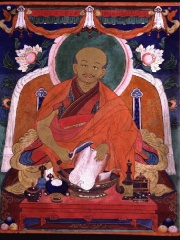
The Most Famous
RELIGIOUS FIGURES from Mongolia
This page contains a list of the greatest Mongolian Religious Figures. The pantheon dataset contains 3,187 Religious Figures, 1 of which were born in Mongolia. This makes Mongolia the birth place of the 116th most number of Religious Figures behind Burkina Faso, and Azerbaijan.
Top 1
The following people are considered by Pantheon to be the most legendary Mongolian Religious Figures of all time. This list of famous Mongolian Religious Figures is sorted by HPI (Historical Popularity Index), a metric that aggregates information on a biography's online popularity.

1. Zanabazar (1635 - 1723)
With an HPI of 63.74, Zanabazar is the most famous Mongolian Religious Figure. His biography has been translated into 19 different languages on wikipedia.
Öndör Gegeen Zanabazar (born Eshidorji) was the first Jebtsundamba Khutuktu and the first Bogd Gegeen or supreme spiritual authority, of the Gelugpa (Yellow Hat) lineage of Tibetan Mahayana Buddhism in Mongolia. The son of a Mongol Tüsheet Khan, Zanabazar was declared spiritual leader of Khalkha Mongols by a convocation of nobles in 1639 when he was just four years old. The 5th Dalai Lama (1617–1682) later recognized him as the reincarnation of the Buddhist scholar Taranatha and bestowed on him the Sanskrit name Jñānavajra (Sanskrit: ज्ञानवज्र, Zanabazar in Mongolian) meaning "thunderbolt scepter of wisdom". Over the course of nearly 60 years, Zanabazar advanced the Gelugpa school of Buddhism among the Mongols, supplanting or synthesizing Sakya or "Red Hat" Buddhist traditions that had prevailed in the area, while strongly influencing social and political developments in 17th century Mongolia. His close ties with both Khalka Mongol leaders and the devout Kangxi Emperor facilitated the Khalkha's submission to Qing rule in 1691. In addition to his spiritual and political roles, Zanabazar was a polymath – a prodigious sculptor, painter, architect, poet, costume designer, scholar and linguist, who is credited with launching Mongolia's seventeenth century cultural renaissance. He is best known for his intricate and elegant Buddhist sculptures created in the Nepali-derived style, two of the most famous being the White Tara and Varajradhara, sculpted in the 1680s. To aid translation of sacred Tibetan texts, he created the Soyombo script from which sprang the Soyombo that later became a national symbol of Mongolia. Zanabazar used his artistic output to promote Buddhism among all levels of Khalkha society and unify Khalkha Mongol tribes during a time of social and political turmoil.
People
Pantheon has 1 people classified as Mongolian religious figures born between 1635 and 1635. Of these 1, none of them are still alive today. The most famous deceased Mongolian religious figures include Zanabazar.

